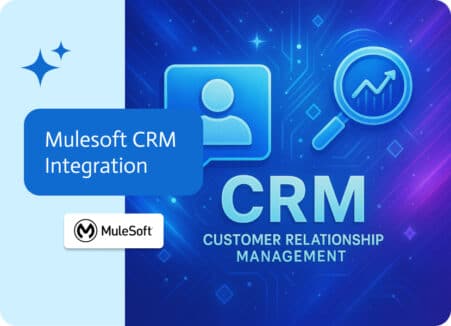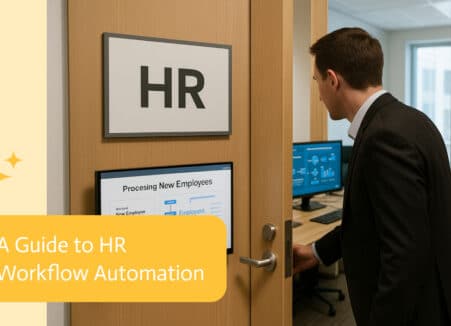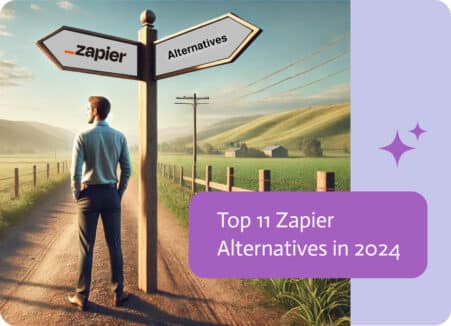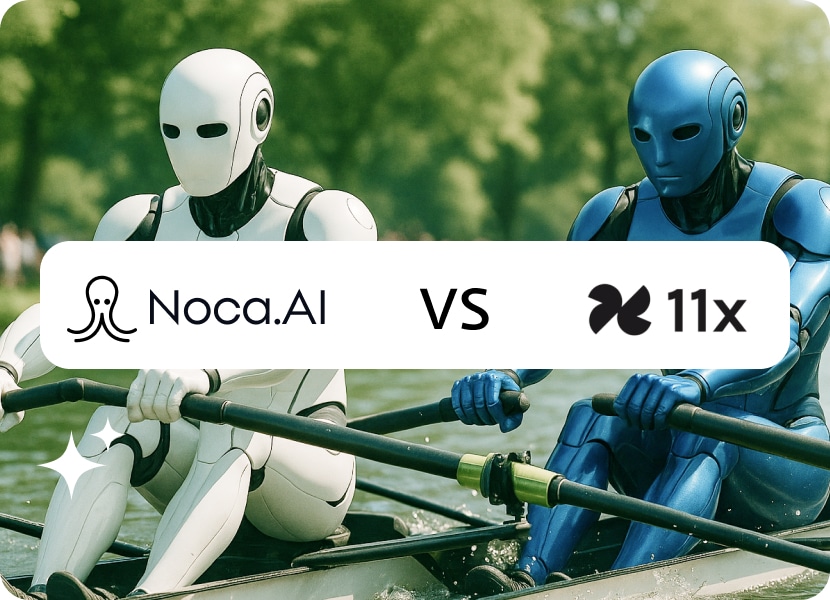
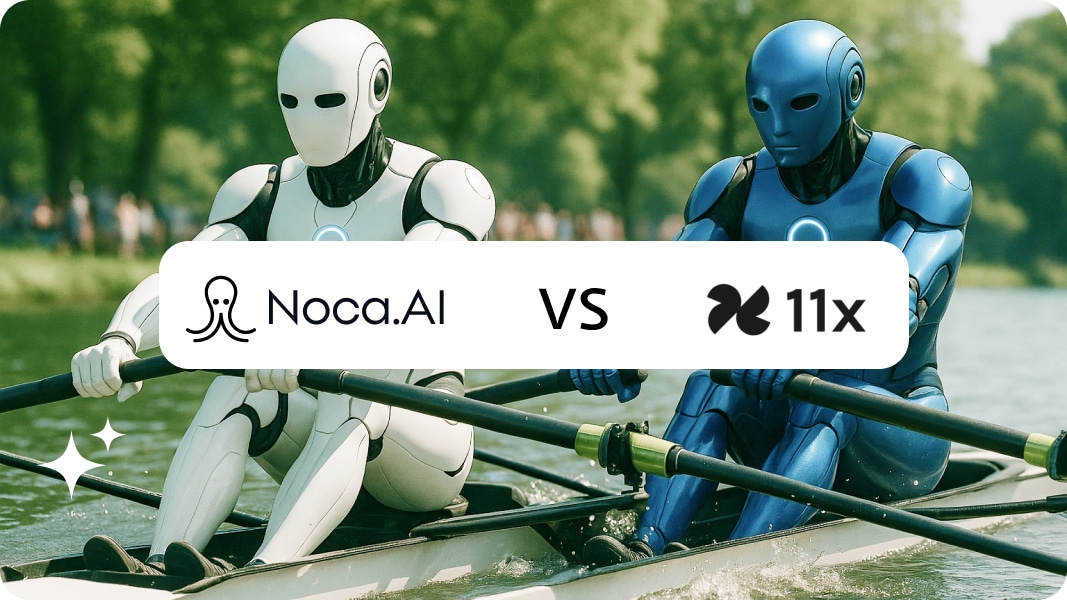
Noca vs. 11x: Which Digital Employee Platform is Best
The AI revolution promised us flying cars and robot butlers. Instead, we got digital employees who can close sales deals, process loan applications, and sync enterprise systems without complaining about the coffee machine. Honestly? That might be better. Two platforms, Noca vs. 11x, are trying to be the definition of digital employees in the future.
11x, the sales automation darling backed by Andreessen Horowitz with $76 million in funding, and Noca, the enterprise-grade AI agent builder designed to integrate with everything your business already uses. Both promise to revolutionize your workforce, but which one solves your actual business problems?
Understanding Digital Employees vs. Sales Bots
We’re not talking about chatbots with delusions of grandeur here. Digital employees are autonomous agents adept at completing end-to-end business processes, making decisions, understanding what’s going on, and taking care of jobs without people constantly telling them what to do.
11x’s digital workers are designed to take control of handling entire job categories autonomously. They’ve named their agents like actual team members: Alice for sales development and Julian for phone conversations, with plans to launch up to 20 other different specialized agents throughout 2025.
Noca deviates from the usual strategy. Noca is a digital employee builder rather than a collection of prepackaged agents with predetermined job titles. This enables anyone to create unique digital employees on their own that are connected to their systems and other enterprise platforms bidirectionally. Just state in plain English what functionality is required, and the platform will figure it out and take care of the rest.
Basically, 11x gives you specialist employees that are good at specific sales roles. Noca, however, gives you the tools to build whatever kind of digital employee your unique business actually needs with simple prompts.
Sales Specialization: 11x Domain
Let’s give credit where it’s due. 11x is working with IBM to integrate their digital workers into watsonx Orchestrate, bringing their AI sales agents to enterprise customers globally. That’s serious enterprise validation.
Alice, which is their flagship digital worker, transforms markets into revenue by engaging prospects across channels, driving qualified meetings, and building pipeline. Julian learns from every call and adapts to business needs. 11x handles prospecting, multi-channel outreach, reply management, and meeting scheduling. You know all the repetitive tasks that make junior SDRs question life.
11x’s digital employees offer impressive data depth with 17+ signal providers and enterprise-grade deliverability that’s five times higher than standard tools. For companies with large addressable markets that need high-volume outreach, this is genuinely powerful. It operates 24/7, never takes vacations, and doesn’t get discouraged when prospects ghost you for the third time.
But here’s where reality gets messy. While 11x positions itself as a full-on replacement for staff SDRs, the reality is a little more nuanced. It’s probably best looked at like an automation tool rather than a true SDR replacement. The personalization can sometimes feel templated or generic, rather than truly custom, and there’s a bigger issue we need to address: pricing.
There’s no clear pricing page on the website, with varied reports online starting at around $1,230 with a six-month discount, ranging up to $5,000 per month. Estimates suggest an annual cost of $50,000 to $60,000, that’s around $5,000 per month for 3,000 email contacts at the end of the day, and that’s not a typo either, we’re talking about the cost of an actual human SDR, except 11x requires you to have an annual contract.
The Integration: Noca vs. 11x
You may be able to build the world’s “smartest” AI sales agent, but if it can’t talk to your ERP system, sync with your CRM, update your warehouse management platform, or effortlessly integrate with that legacy system your CFO refuses to replace, you’ve basically built an expensive island, unfortunately.
11x integrates with CRMs to improve data utilization, which handles basic sales workflows. For companies with straightforward tech stacks like Salesforce here or HubSpot there, then this will probably work just fine. But enterprise environments are almost never that simple to operate in.
Here’s the catch: 11x depends on several third-party providers for key functions like contact data, LinkedIn automation, and email warm-up. This dependency may cause delays with issue resolution and will potentially mean an increase in costs. More importantly, it cannot function as a standalone platform, requiring an existing subscription with a sales engagement platform and dialer. You’re not getting rid of your tools, just adding more.
Most platforms run into problems with true integration. By integrating more than 500 apps and services, such as marketing tools, CRM, ERP, and e-commerce platforms, Noca radically alters the rules of the game. In order to automate processes, monitor data, and take proactive measures across all of these systems, our AI Agent Orchestration deploys intelligent agents.
However, the sheer quantity of connections is not the only factor. Every app that Noca offers bidirectional integrations with has been verified to adhere to the TRAPS framework (Trusted, Responsible, Auditable, Private, and Secure). This implies that you immediately get enterprise-grade compliance and peace of mind.
Both platforms maintain flawless synchronization of customer information, product details, invoice statuses, and shipping details. That’s orchestration throughout your whole business ecosystem, not just basic automation but rather orchestration across your entire business ecosystem.
Building Your Digital Workforce: The Noca vs. 11x Approaches
11x gives you specialists. The company spent 7-8 months working closely with design partners, literally sitting beside SDRs to observe their daily routines, analyzing differences between top performers and average SDRs, then incorporating these insights into their digital worker designs.
That deep specialization is powerful—if your needs match their specialists. But what happens when your business requires something slightly different? Or when you need an agent that handles a workflow 11x never anticipated? You’re out of luck. 11x onboarding takes 2-3 weeks, with much of the persona-building and message fine-tuning left to the user, requiring continuous monitoring of domain health.
Noca enables users to clearly state their business needs. After processing this natural language intent, the platform provides the appropriate solution immediately, be it a custom AI agent, an automation script, or a new app.
Do you need a Digital Loan Officer to manage the entire process, make automated document requests, confirm identities, communicate with credit agencies, and grant conditional approvals? Simply explain it. Do you want an agent that keeps track of stock levels in five different systems and places new orders automatically when thresholds are lowered? Tell Noca what you would like it to do.
The secret to speed is teamwork. In a single shared environment, Noca enables team members to co-design, comment on prompts, and iterate.
Noca vs. 11x: Context-Aware vs. Smart
Both platforms use large language models, but they apply that intelligence differently, and those differences matter when your AI agent is making actual business decisions.
11x’s digital workers learn and adapt continuously, expanding knowledge and maximizing performance with every interaction, building lasting and contextual memory that transforms past insights into future performance. Their agents are trained specialists. Alice knows sales. Julian knows phone conversations. They’re good at their specific jobs, and they get better with repetition.
Noca AI gives its agents the ability to learn, change, and react in real time. They are able to process fresh data, identify evolving business circumstances, and make astute workflow adjustments. By enabling AI Agents to read data from any system, evaluate real-time insights, and make wise decisions, this platform facilitates context-aware decision-making.
Only their job description is known to other agents. Your whole business context is understood by Noca’s agents. Noca AI does more than just react; it streamlines processes, finds inefficiencies, suggests the best course of action for the future, and gives agents the ability to take initiative. It’s the difference between an employee who waits for orders and one who fixes a developing issue across three different systems before anyone else does.
Performance and Reliability in Production
Pretty demos are useless when you’ve got 10,000 customer requests that need processing and your digital employee decides to take an unscheduled nap.
11x is increasing productivity for thousands of subject-matter experts at companies including Qualified, Activision, and SafetyCulture. Their agents handle real work at real companies. However, based on user experiences, it takes time to see meaningful outcomes. New email domains need time to build reputation, personalization requires fine-tuning iteration, and some users have reported challenges with specific CRM setups.
The value of 11x is consistency at scale. No missed nudges, no pipeline gaps, and a steady flow of conversations, which, for high-volume sales operations, that consistency has value.
With built-in auto-scaling, performance tuning, and fault tolerances, Noca is designed for production use. This guarantees that as usage increases, your application will remain dependable and quick. Through an easy-to-use dashboard, you’ll be able to track all processes, keep an eye on the health of the flow, and troubleshoot problems incredibly easily. Agents can instantly modify workflows to keep up with rapid changes thanks to real-time adaptation.
The impact in the real world happens quickly. Because of streamlined delivery, speedier dev cycles, and a decrease in errors, businesses usually see measurable ROI in just a few weeks. Instead of waiting months for configuration, you receive returns right away.
Security, Compliance, and Staying Out of Trouble
Your digital employees will indefinitely have access to all sorts of significantly sensitive information, as well as be given free rein to make some pretty important financial decisions. One breach of security could easily end careers, so this matters more than anything else, really.
11x maintains the highest security standards with SOC-2 compliance and end-to-end encryption of all customer data and regularly ticks the compliance boxes that procurement departments care about.
Every Noca app follows the TRAPS framework, delivering enterprise-grade compliance that’s baked into every agent from conception. Noca AI follows security protocols strictly, as well as encryption, role-based authorizations, and reports, making it fully compliant with major global standards.
For enterprises in regulated industries, this level of governance isn’t nice to have; it’s mandatory. The difference between platforms here isn’t just the features, it’s whether you can actually deploy these agents without your compliance team panicking.
Noca vs 11x Pricing
11x’s pricing deserves scrutiny. Annual costs range from $50,000 to $60,000, with costs per email at $1.67. The platform locks users into annual contracts between 1-3 years, and while they offer a 3-month opt-out period, although some users have mentioned that they’ve had a hard time when trying to cancel subscriptions.
At $900 per month, competing solutions like Noca are up to 80% cheaper than 11x. That price delta isn’t trivial at all, it’s the difference between experimenting and making a bet-the-company commitment.
Noca’s experimental free package is designed for anyone getting started with automation who doesn’t really want to make the commitment of paying just yet. The starter kit for small- to medium-sized teams is $20, and an Enterprise tier is perfect for large enterprises with complex integration needs and high-volume requirements.
More importantly, with Noca AI, enterprises don’t need to pay for months when building customized integrations or hire expensive consultants to automate their business processes. That’s where the real ROI lives, not in subscription costs, but in the time it takes to accomplish and avoid six-figure consulting bills. Noca’s flexible pricing allows switching plans as business and integration needs evolve, which helps to make sure you only pay for features and capacities you need.
Use Cases: Noca vs. 11x
11x works best for high-volume B2B sales operations with large addressable markets that need thousands of outbound touches monthly. Companies replacing or scaling SDR teams specifically focused on pipeline generation and meeting booking will find value here. Organizations with simple tech stacks and standard CRM plus email plus LinkedIn that don’t require deep system integration can deploy 11x effectively. Businesses prioritizing lead volume over deep personalization, where quantity drives conversion through statistical probability, fit 11x’s strengths.
Noca is intended for sophisticated, enterprise-level businesses that work in multi-system settings and need to integrate CRM, ERP, and those older legacy platforms deeply. Noca’s TRAPS framework, which ensures security, compliance, and audit trails, is used by the government, healthcare, and other heavily regulated sectors.
Noca’s digital employee adaptability is a key criterion for any business creating distinctive workflows outside of sales, such as loan processing, operations orchestration, onboarding, and RevOps automation. Noca’s architecture is advantageous, especially for businesses that require strong, enterprise-grade reliability with capabilities like auto-scaling and real-time adaptation. Noca will yield faster returns if you want agents operating in a matter of hours and providing an instant return on investment.
The Real Question: Noca vs. 11x
By the end of 2025, digital employees will be as common as Slack channels. The question isn’t whether to build a digital workforce, simply because market forces have made that decision for you. So, do you want specialists optimized for sales, or do you want the tools to build whatever kind of digital employees your unique business actually needs?
11x brings impressive sales automation, significant funding, and a growing roster of enterprise customers. For companies where sales is the primary constraint and budget isn’t a concern, they’ve built something genuinely valuable. Their specialists excel at what they do, and that focus has clear benefits for organizations with straightforward sales-centric needs.
But Noca brings something different: enterprise-grade infrastructure, deep integration, AI agents that understand your business across systems, and a platform designed for business users. If your digital employees need to do more than just book meetings or need to manage complex workflows across integrated systems, Noca is built for that.
Choose 11x if you need to scale SDR operations, have a simple tech setup, can afford the price, and want specialists for sales tasks.
Choose Noca if you need digital employees that integrate deeply with enterprise systems, operate in regulated industries, want to build custom agents, need reliable auto-scaling, prioritize a quick return on investment, and want business users to build and use agents without IT getting in the way.
